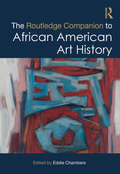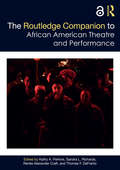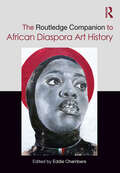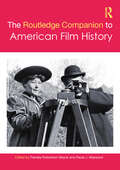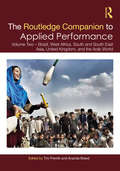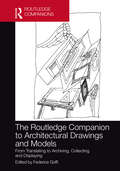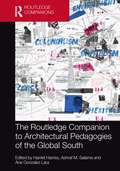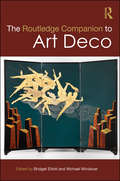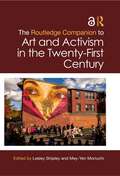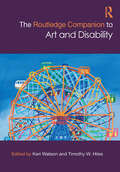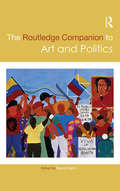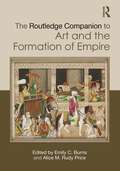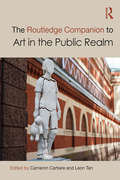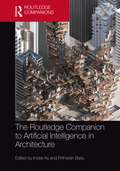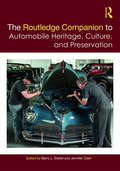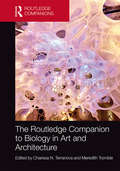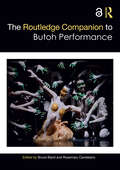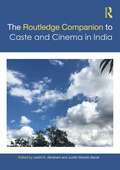- Table View
- List View
The Routledge Companion to Adaptation (Routledge Companions)
by Dennis Cutchins Katja Krebs Eckart VoigtsThe Routledge Companion to Adaptation offers a broad range of scholarship from this growing, interdisciplinary field. With a basis in source-oriented studies, such as novel-to-stage and stage-to-film adaptations, this volume also seeks to highlight the new and innovative aspects of adaptation studies, ranging from theatre and dance to radio, television and new media. It is divided into five sections: Mapping, which presents a variety of perspectives on the scope and development of adaptation studies; Historiography, which investigates the ways in which adaptation engages with – and disrupts – history; Identity, which considers texts and practices in adaptation as sites of multiple and fluid identity formations; Reception, which examines the role played by an audience, considering the unpredictable relationships between adaptations and those who experience them; Technology, which focuses on the effects of ongoing technological advances and shifts on specific adaptations, and on the wider field of adaptation. An emphasis on adaptation-as-practice establishes methods of investigation that move beyond a purely comparative case study model. The Routledge Companion to Adaptation celebrates the complexity and diversity of adaptation studies, mapping the field across genres and disciplines.
The Routledge Companion to African American Art History (Routledge Art History and Visual Studies Companions)
by Eddie ChambersThis Companion authoritatively points to the main areas of enquiry within the subject of African American art history. The first section examines how African American art has been constructed over the course of a century of published scholarship. The second section studies how African American art is and has been taught and researched in academia. The third part focuses on how African American art has been reflected in art galleries and museums. The final section opens up understandings of what we mean when we speak of African American art. This book will be of interest to graduate students, researchers, and professors and may be used in American art, African American art, visual culture, and culture classes.
The Routledge Companion to African American Theatre and Performance (Routledge Companions)
by Kathy A. Perkins Sandra L. Richards Renée Alexander Craft Thomas F. DeFrantzThe Routledge Companion to African American Theatre and Performance is an outstanding collection of specially written essays that charts the emergence, development, and diversity of African American Theatre and Performance—from the nineteenth-century African Grove Theatre to Afrofuturism. Alongside chapters from scholars are contributions from theatre makers, including producers, theatre managers, choreographers, directors, designers, and critics. This ambitious Companion includes: A "Timeline of African American theatre and performance." Part I "Seeing ourselves onstage" explores the important experience of Black theatrical self-representation. Analyses of diverse topics including historical dramas, Broadway musicals, and experimental theatre allow readers to discover expansive articulations of Blackness. Part II "Institution building" highlights institutions that have nurtured Black people both on stage and behind the scenes. Topics include Historically Black Colleges and Universities (HBCUs), festivals, and black actor training. Part III "Theatre and social change" surveys key moments when Black people harnessed the power of theatre to affirm community realities and posit new representations for themselves and the nation as a whole. Topics include Du Bois and African Muslims, women of the Black Arts Movement, Afro-Latinx theatre, youth theatre, and operatic sustenance for an Afro future. Part IV "Expanding the traditional stage" examines Black performance traditions that privilege Black worldviews, sense-making, rituals, and innovation in everyday life. This section explores performances that prefer the space of the kitchen, classroom, club, or field. This book engages a wide audience of scholars, students, and theatre practitioners with its unprecedented breadth. More than anything, these invaluable insights not only offer a window onto the processes of producing work, but also the labour and economic issues that have shaped and enabled African American theatre.
The Routledge Companion to African Diaspora Art History (Routledge Art History and Visual Studies Companions)
by Eddie ChambersThis is an authoritative companion that is global in scope, recognizing the presence of African Diaspora artists across the world. It is a bold and broad reframing of this neglected branch of art history, challenging dominant presumptions about the field.Diaspora pertains to the global scattering or dispersal of, in this instance, African peoples, as well as their patterns of movement from the mid twentieth century onwards. Chapters in this book emphasize the importance of cross-fertilization, interconnectedness, and intersectionality in the framing of African Diaspora art history. The book stresses the complexities of artists born within, or living and working within, the African continent, alongside the complexities of Africa-born artists who have migrated to other parts of the world. The group of international contributors emphasizes and accentuates the interplay between, for example, Caribbean art and African Diaspora art, or Latin American art and African Diaspora art, or Black British art and African Diaspora art.The book will be of interest to scholars and students working in art history, the various branches of African studies, African American studies, African Diaspora studies, Caribbean studies, and Latin American studies.
The Routledge Companion to American Film History (Routledge Media and Cultural Studies Companions)
by Paula J. MassoodPresenting new and diverse scholarship, this collection brings together original essays that explore American film history from a fresh perspective.Comprising an introduction and 34 chapters written by leading scholars from around the globe, and edited by Pamela Robertson Wojcik and Paula J. Massood, this collection offers discussions of the American film industry from previously unexplored vantage points. Rather than follow a chronological format, as with most film histories, this Companion offers a multiplicity of approaches to historiography and is arranged according to often underdeveloped or overlooked areas in American film, including topics such as alternate archives, hidden labor, histories of style, racialized technologies, cinema’s material cultures, spectators and fans, transnational film production, intermedial histories, history in and about films, and the historical afterlives of cinema.An exciting collection for serious film studies students and scholars interested in new perspectives and fresh approaches to thinking about and doing American film history.
The Routledge Companion to Applied Performance: Volume One – Mainland Europe, North and Latin America, Southern Africa, and Australia and New Zealand (Routledge Companions)
by Tim Prentki and Ananda BreedThe Routledge Companion to Applied Performance provides an in-depth, far-reaching and provocative consideration of how scholars and artists negotiate the theoretical, historical and practical politics of applied performance, both in the academy and beyond. These volumes offer insights from within and beyond the sphere of English-speaking scholarship, curated by regional experts in applied performance. The reader will gain an understanding of some of the dominant preoccupations of performance in specified regions, enhanced by contextual framing. From the dis(h)arming of the human body through dance in Colombia to clowning with dementia in Australia, via challenges to violent nationalism in the Balkans, transgender performance in Pakistan and resistance rap in Kashmir, the essays, interviews and scripts are eloquent testimony to the courage and hope of people who believe in the power of art to renew the human spirit. Students, academics, practitioners, policy-makers, cultural anthropologists and activists will benefit from the opportunities to forge new networks and develop in-depth comparative research offered by this bold, global project.
The Routledge Companion to Applied Performance: Volume Two – Brazil, West Africa, South and South East Asia, United Kingdom, and the Arab World (Routledge Companions)
by Tim Prentki and Ananda BreedThe Routledge Companion to Applied Performance provides an in-depth, far-reaching and provocative consideration of how scholars and artists negotiate the theoretical, historical and practical politics of applied performance, both in the academy and beyond. These volumes offer insights from within and beyond the sphere of English-speaking scholarship, curated by regional experts in applied performance. The reader will gain an understanding of some of the dominant preoccupations of performance in specified regions, enhanced by contextual framing. From the dis(h)arming of the human body through dance in Colombia to clowning with dementia in Australia, via challenges to violent nationalism in the Balkans, transgender performance in Pakistan and resistance rap in Kashmir, the essays, interviews and scripts are eloquent testimony to the courage and hope of people who believe in the power of art to renew the human spirit. Students, academics, practitioners, policy-makers, cultural anthropologists and activists will benefit from the opportunities to forge new networks and develop in-depth comparative research offered by this bold, global project.
The Routledge Companion to Architectural Drawings and Models: From Translating to Archiving, Collecting and Displaying (Routledge International Handbooks)
by Federica GoffiArchitectural drawings and models are instruments of imagination, communication, and historical continuity. The role of drawings and models, and their ownership, placement, and authorship in a ubiquitous digital age deserve careful consideration. Expanding on the well-established discussion of the translation from drawings to buildings, this book fills a lacuna in current scholarship, questioning the significance of the lives of drawings and models after construction. Including emerging, well-known, and world-renowned scholars in the fields of architectural history and theory and curatorial practices, the thirty-five contributions define recent research in four key areas: drawing sites/sites of knowledge construction: drawing, office, construction site; the afterlife of drawings and models: archiving, collecting, displaying, and exhibiting; tools of making: architectural representations and their apparatus over time; and the ethical responsibilities of collecting and archiving: authorship, ownership, copyrights, and rights to copy. The research covers a wide range of geographies and delves into the practices of such architects as Sir John Soane, Superstudio, Eugène-Emmanuel Viollet-le-Duc, Frank Lloyd Wright, Wajiro Kon, Germán Samper Gnecco, A+PS, Mies van der Rohe, and Renzo Piano.
The Routledge Companion to Architectural Pedagogies of the Global South (Routledge International Handbooks)
by Harriet HarrissThe established canon of architectural pedagogy has been predominantly produced within the Northern hemisphere and transposed – or imposed – across schools within the Global South, more often, with scant regard for social, economic, political or ecological culture and context, nor regional or indigenous pedagogic principles and practices. Throughout the Global South, architecture’s academic community has been deeply affected by this regime, how it shapes and influences proto-professionals and by implication architectural processes and outcomes, too. The Routledge Companion to Architectural Pedagogies of the Global South resituates and recenters an array of pedagogic approaches that are either produced or proliferate from the ‘Global South’ while antagonizing the linguistic, epistemological and disciplinary conceits that, under imperialist imperatives, ensured that these pedagogies remained maligned or marginalized. The book maintains that the exclusionary implications of architectural notions of the ‘orders’, the ‘canon’ and the ‘core’ have served to constrain and to calcify its contents and in doing so, imperiled its relevance and impact. In contrast, this companion of pedagogic approaches serves to evidence that architecture’s academic and professional advancement is wholly contingent on its ability to fully engage in an additive and inclusive process whereby the necessary disruptions that occur when marginalized knowledge confronts established knowledge result in a catalytical transformation through which new, co-created knowledge can emerge. Notions of tradition, identity, modernity, vernacularism, post-colonialism, poverty, migration, social and spatial justice, climate apartheid, globalization, ethical standards and international partnerships are key considerations in the context of the Global South. How these issues originate and evolve within architectural schools and curricula and how they act as drivers across all curricula activities are some of the important themes that the contributors interrogate and debate. With more than 30 contributions from 55 authors from diverse regional, racial, ethnic, gender and cultural backgrounds, this companion is structured in four sections that capture, critique and catalog multifarious marginalized pedagogical approaches to provide educators and students with an essential source book of navigational steers, core contestations, propositional tactics and reimagined rubrics. The Routledge Companion to Architectural Pedagogies of the Global South pioneers a transposable strategy for academics from all disciplines looking to adopt a tested approach to decolonizing the curriculum. It is only through a process of destabilizing the hegemonic, epistemological and disciplinary frameworks that have long-prescribed architecture’s pedagogies that the possibility of more inclusive, representative and relevant pedagogical practices can emerge.
The Routledge Companion to Architecture and Social Engagement
by Farhan KarimSocially engaged architecture is a broad and emerging architectural genre that promises to redefine architecture from a market-driven profession to a mix of social business, altruism, and activism that intends to eradicate poverty, resolve social exclusion, and construct an egalitarian global society. The Routledge Companion to Architecture and Social Engagement offers a critical enquiry of socially engaged architecture’s current context characterized by socio-economic inequity, climate change, war, increasing global poverty, microfinance, the evolving notion of professionalism, the changing conception of public, and finally the growing academic interest in re-visioning the social role of architecture. Organized around case studies from the United States, Brazil, Venezuela, the United Kingdom, South Africa, Rwanda, Burkina Faso, Nigeria, Nepal, Pakistan, Iran, Thailand, Germany, Australia, Taiwan, and Japan the book documents the most important recent developments in the field. By examining diverse working methods and philosophies of socially engaged architecture, the handbook shows how socially engaged architecture is entangled in the global politics of poverty, reconstruction of the public sphere, changing role of the state, charity, and neoliberal urbanism. The book presents debates around the issue of whether architecture actually empowers the participators and alleviates socio-economic exclusion or if it instead indirectly sustains an exploitive capitalism. Bringing together a range of theories and case studies, this companion offers a platform to facilitate future lines of inquiry in education, research, and practice.
The Routledge Companion to Art Deco (Routledge Art History and Visual Studies Companions)
by Bridget Elliott Michael WindoverScholarly interest in Art Deco has grown rapidly over the past fifty years, spanning different academic disciplines. This volume provides a guide to the current state of the field of Art Deco research by highlighting past accomplishments and promising new directions. Chapters are presented in five sections based on key concepts: migration, public culture, fashion, politics, and Art Deco’s afterlife in heritage restoration and new media. The book provides a range of perspectives on and approaches to these issues, as well as to the concept of Art Deco itself. It highlights the slipperiness of Art Deco yet points to its potential to shed new light on the complexities of modernity.
The Routledge Companion to Art and Activism in the Twenty-First Century (Routledge Art History and Visual Studies Companions)
by Mey-Yen Moriuchi Lesley ShipleyThe Routledge Companion to Art and Activism in the Twenty-First Century brings together a wide range of geographical, cultural, historical, and conceptual perspectives in a single volume of new essays that facilitate a deeper understanding of the field of art activism as it stands today and as it looks towards the future. The book is a resource for multiple fields, including art activism, socially engaged art, and contemporary art, that represent the depth and breadth of contemporary activist art worldwide. Contributors highlight predominant lines of inquiry, uncover challenges faced by scholars and practitioners of activist art, and facilitate dialogue that might lead to new directions for research and practice. The editors hope that the volume will incite further conversation and collaboration among the various participants, practitioners, and researchers concerned with the relationship between art and activism. The audience includes scholars and professors of modern and contemporary art, students in both graduate and upper-level undergraduate programs, as well as artists, curators, and museum professionals. Each chapter can stand on its own, making the companion a flexible resource for students and educators working in art history, museum studies, community practice/socially engaged art, political science, sociology, and ethnic and cultural studies.
The Routledge Companion to Art and Disability (Routledge Art History and Visual Studies Companions)
by Keri Watson Timothy W. HilesThe Routledge Companion to Art and Disability explores disability in visual culture to uncover the ways in which bodily and cognitive differences are articulated physically and theoretically, and to demonstrate the ways in which disability is culturally constructed. This companion is organized thematically and includes artists from across historical periods and cultures in order to demonstrate the ways in which disability is historically and culturally contingent. The book engages with questions such as: How are people with disabilities represented in art? How are notions of disability articulated in relation to ideas of normality, hybridity, and anomaly? How do artists use visual culture to affirm or subvert notions of the normative body? Contributors consider the changing role of disability in visual culture, the place of representations in society, and the ways in which disability studies engages with and critiques intersectional notions of gender, race, ethnicity, class, and sexuality.This book will be particularly useful for scholars in art history, disability studies, visual culture, and museum studies.
The Routledge Companion to Art and Politics (Routledge Art History and Visual Studies Companions)
by Randy Martin Victor J. PetersonThe Routledge Companion to Art and Politics offers a thorough examination of the complex relationship between art and politics, and the many forms and approaches the engagement between them can take. The contributors - a diverse assembly of artists, activists, scholars from around the world – discuss and demonstrate ways of making art and politics legible and salient in the world. As such the 32 chapters in this volume reflect on performing and visual arts; music, film and new media; as well as covering social practice, community-based work, conceptual, interventionist and movement affiliated forms. The Companion is divided into four distinct parts: Conceptual Cartographies Institutional Materialities Modalities of Practice Making Publics Randy Martin has assembled a collection that ensures that readers will come away with a wider view of what can count as art and politics; where they might find it; and how it moves in the world. The diversity of perspectives is at once challenging and fortifying to those who might dismiss political art on the one hand as not making sufficient difference and on the other to those embracing it but seeking a means to elaborate the significance that it can make in the world. The Routledge Companion to Art and Politics brings together a range of issues and approaches and encourages critical and creative thinking about how art is produced, perceived, and received.
The Routledge Companion to Art and the Formation of Empire (Routledge Art History and Visual Studies Companions)
by Emily C. Burns Rudy Price, Alice M.This companion comprises essays that analyze interactions between art and global imperial relationships from 1800 to World War II.The essays in this volume expose and add to historical layers of meaning in their discussions of art and empire. Found across much of the globe, sites of sedimentary rock allegorize the dynamics of art and empire and frame the section structure for this book. Twenty‑two authors unpack imperial layers in a variety of global and historical contexts through case studies that center art and visual and material culture. The authors show how art and aesthetics have operated as tools of empire. Interpreting a comprehensive array of media as well as inter‑media dialogues, they analyze and intervene in how we remember and examine entwinements between empire and aesthetic practices. In this volume’s attention to the role of art in imperial formation, as well as the legacy of colonization, the essays disentangle sediments of culture as they are moved and shaped by homogenizing forces of empire, showing that the aesthetics of empire inflect not only individuals, makers, and economies, but also practices of circulation and collecting.The book will be of interest to graduate students, researchers, and professors and may be used in classes focused on art history, imperialism, and colonialism.
The Routledge Companion to Art in the Public Realm (Routledge Art History and Visual Studies Companions)
by Cameron CartiereThis multidisciplinary companion offers a comprehensive overview of the global arena of public art. It is organised around four distinct topics: activation, social justice, memory and identity, and ecology, with a final chapter mapping significant works of public and social practice art around the world between 2008 and 2018. The thematic approach brings into view similarities and differences in the recent globalisation of public art practices, while the multidisciplinary emphasis allows for a consideration of the complex outcomes and consequences of such practices, as they engage different disciplines and communities and affect a diversity of audiences beyond the existing 'art world'. The book will highlight an international selection of artist projects that illustrate the themes. This book will be of interest to scholars in contemporary art, art history, urban studies, and museum studies.
The Routledge Companion to Art in the Public Realm (Routledge Art History and Visual Studies Companions)
by Cameron CartiereThis multidisciplinary companion offers a comprehensive overview of the global arena of public art.It is organised around four distinct topics: activation, social justice, memory and identity, and ecology, with a final chapter mapping significant works of public and social practice art around the world between 2008 and 2018. The thematic approach brings into view similarities and differences in the recent globalisation of public art practices, while the multidisciplinary emphasis allows for a consideration of the complex outcomes and consequences of such practices, as they engage different disciplines and communities and affect a diversity of audiences beyond the existing 'art world'. The book will highlight an international selection of artist projects that illustrate the themes.This book will be of interest to scholars in contemporary art, art history, urban studies, and museum studies.
The Routledge Companion to Artificial Intelligence in Architecture
by Imdat As and Prithwish BasuProviding the most comprehensive source available, this book surveys the state of the art in artificial intelligence (AI) as it relates to architecture. This book is organized in four parts: theoretical foundations, tools and techniques, AI in research, and AI in architectural practice. It provides a framework for the issues surrounding AI and offers a variety of perspectives. It contains 24 consistently illustrated contributions examining seminal work on AI from around the world, including the United States, Europe, and Asia. It articulates current theoretical and practical methods, offers critical views on tools and techniques, and suggests future directions for meaningful uses of AI technology. Architects and educators who are concerned with the advent of AI and its ramifications for the design industry will find this book an essential reference.
The Routledge Companion to Arts Marketing (Routledge Companions in Business, Management and Accounting)
by Daragh O'Reilly Ruth Rentschler Theresa A. KirchnerThe relationship between the arts and marketing has been growing ever more complex, as the proliferation of new technologies and social media has opened up new forms of communication. This book covers the broad and involved relationship between the arts and marketing. It frames "arts marketing" in the context of wider, related issues, such as the creative and cultural industries, cultural policy and arts funding, developments in the different art forms and the impact of environmental forces on arts business models and markets. The Routledge Companion to Arts Marketing provides a comprehensive, up-to-date reference guide that incorporates current analyses of arts marketing topics by leaders of academic research in the field. As such, it will be a key resource for the next generation of arts marketing scholars and teachers and will constitute the single most authoritative guide on the subject internationally.
The Routledge Companion to Automobile Heritage, Culture, and Preservation (Routledge Companions)
by Jennifer Clark Barry StiefelThe Routledge Companion to Automobile Heritage, Culture, and Preservation explores automotive heritage, its place in society, and the ways we might preserve and conserve it. Drawing on contributions from academics and practitioners around the world and comprising six sections, this volume carries the heritage discourse forward by exploring the complex and sometimes intricate place of automobiles within society. Taken as a whole, this book helps to shape how we think about automobile heritage and considers how that heritage explores a range of cultural, intellectual, emotional, and material elements well outside of the automobile body itself. Most importantly, perhaps, it questions how we might better acknowledge the importance of automotive heritage now and in the future. The Routledge Companion to Automobile Heritage, Culture, and Preservation is unique in that it juxtaposes theory with practice, academic approaches with practical experience, and recognizes that issues of preservation and conservation belong in a broad context. As such, this volume should be essential reading for both academics and practitioners with an interest in automobiles, cultural heritage, and preservation.
The Routledge Companion to Biology in Art and Architecture
by Meredith Tromble Charissa N. TerranovaThe Routledge Companion to Biology in Art and Architecture collects thirty essays from a transdisciplinary array of experts on biology in art and architecture. The book presents a diversity of hybrid art-and-science thinking, revealing how science and culture are interwoven. The book situates bioart and bioarchitecture within an expanded field of biology in art, architecture, and design. It proposes an emergent field of biocreativity and outlines its historical and theoretical foundations from the perspective of artists, architects, designers, scientists, historians, and theoreticians. Includes over 150 black and white images.
The Routledge Companion to Biology in Art and Architecture
by Meredith Tromble Charissa N. TerranovaThe Routledge Companion to Biology in Art and Architecture collects thirty essays from a transdisciplinary array of experts on biology in art and architecture. The book presents a diversity of hybrid art-and-science thinking, revealing how science and culture are interwoven. The book situates bioart and bioarchitecture within an expanded field of biology in art, architecture, and design. It proposes an emergent field of biocreativity and outlines its historical and theoretical foundations from the perspective of artists, architects, designers, scientists, historians, and theoreticians. Includes over 150 black and white images.
The Routledge Companion to Butoh Performance (Routledge Companions)
by Rosemary Candelario Bruce BairdThe Routledge Companion to Butoh Performance provides a comprehensive introduction to and analysis of the global art form butoh. Originating in Japan in the 1960s, butoh was a major innovation in twentieth century dance and performance, and it continues to shape-shift around the world. Taking inspiration from the Japanese avant-garde, Surrealism, Happenings, and authors such as Genet and Artaud, its influence can be seen throughout contemporary performing arts, music, and visual art practices. This Companion places the form in historical context, documents its development in Japan and its spread around the world, and brings together the theory and the practice of this compelling dance. The interdisciplinarity evident in the volume reflects the depth and the breadth of butoh, and the editors bring specially commissioned essays by leading scholars and dancers together with translations of important early texts.
The Routledge Companion to Butoh Performance (Routledge Companions)
by Rosemary Candelario Bruce BairdThe Routledge Companion to Butoh Performance provides a comprehensive introduction to and analysis of the global art form butoh.Originating in Japan in the 1960s, butoh was a major innovation in twentieth century dance and performance, and it continues to shape-shift around the world. Taking inspiration from the Japanese avant-garde, Surrealism, Happenings, and authors such as Genet and Artaud, its influence can be seen throughout contemporary performing arts, music, and visual art practices.This Companion places the form in historical context, documents its development in Japan and its spread around the world, and brings together the theory and the practice of this compelling dance. The interdisciplinarity evident in the volume reflects the depth and the breadth of butoh, and the editors bring specially commissioned essays by leading scholars and dancers together with translations of important early texts.The Open Access version of this book, available at http://www.taylorfrancis.com, has been made available under a Creative Commons Attribution (CC-BY) 4.0 license.
The Routledge Companion to Caste and Cinema in India
by Joshil K. Abraham Judith Misrahi-BarakThis companion is the first study of caste and its representation in Indian cinema. It unravels the multiple layers of caste that feature directly and indirectly in Indian movies, to examine not only the many ways caste pervades Indian society and culture but also how the struggle against it adopts multiple strategies. The companion: • critiques Indian cinema production through the lens of anti-caste discourse; • traces the history of films beginning from the early twentieth century, focusing on caste representations across India, including Hindi, Malayalam, Kannada, Marathi, Bengali, Punjabi, Tamil as well as silent films; • makes a foray into OTT media; • includes analysis of popular films such as Padmaavat, Masaan, Fandry, Sairat, Sujata, Article 15, Chomana Dudi, Lagaan, Court, Ee.Ma.Yau, Kaala, Pariyerum Perumal, Perariyathavar, among many others, to critique and problematise the idea of caste. A major intervention, this book alters traditional approaches to ‘caste’ in Indian cinemas and society and explores new political strategies implemented through cinematic creation and aesthetics. It will be indispensable for scholars and researchers of film studies, social discrimination and exclusion studies, human rights, popular culture, and South Asian studies. It will also be of interest to enthusiasts of Indian cinematic history.

